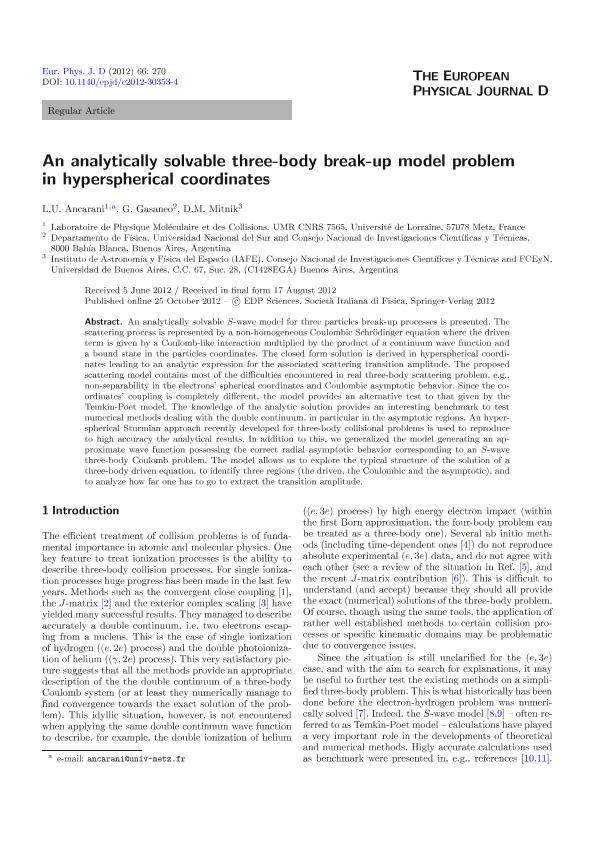Mostrar el registro sencillo del ítem
dc.contributor.author
Ancarani, L. U.
dc.contributor.author
Gasaneo, Gustavo

dc.contributor.author
Mitnik, Dario Marcelo

dc.date.available
2017-07-04T20:19:05Z
dc.date.issued
2012-10
dc.identifier.citation
Ancarani, L. U.; Gasaneo, Gustavo; Mitnik, Dario Marcelo; An analytically solvable three-body break-up model problem in hyperspherical coordinates; Springer; European Physical Journal D; 66; 10-2012; 1-11; 270
dc.identifier.issn
1434-6060
dc.identifier.uri
http://hdl.handle.net/11336/19530
dc.description.abstract
An analytically solvable S-wave model for three particles break-up processes is presented. The scattering process is represented by a non-homogeneous Coulombic Schrödinger equation where the driven term is given by a Coulomb-like interaction multiplied by the product of a continuum wave function and a bound state in the particles coordinates. The closed form solution is derived in hyperspherical coordinates leading to an analytic expression for the associated scattering transition amplitude. The proposed scattering model contains most of the difficulties encountered in real three-body scattering problem, e.g., non-separability in the electrons’ spherical coordinates and Coulombic asymptotic behavior. Since the coordinates’ coupling is completely different, the model provides an alternative test to that given by the Temkin-Poet model. The knowledge of the analytic solution provides an interesting benchmark to test numerical methods dealing with the double continuum, in particular in the asymptotic regions. An hyperspherical Sturmian approach recently developed for three-body collisional problems is used to reproduce to high accuracy the analytical results. In addition to this, we generalized the model generating an approximate wave function possessing the correct radial asymptotic behavior corresponding to an S-wave three-body Coulomb problem. The model allows us to explore the typical structure of the solution of a three-body driven equation, to identify three regions (the driven, the Coulombic and the asymptotic), and to analyze how far one has to go to extract the transition amplitude.
dc.format
application/pdf
dc.language.iso
eng
dc.publisher
Springer

dc.rights
info:eu-repo/semantics/openAccess
dc.rights.uri
https://creativecommons.org/licenses/by-nc-sa/2.5/ar/
dc.subject
Collisions
dc.subject
Hyperspherical
dc.subject
Sturmians
dc.subject.classification
Física Atómica, Molecular y Química

dc.subject.classification
Ciencias Físicas

dc.subject.classification
CIENCIAS NATURALES Y EXACTAS

dc.title
An analytically solvable three-body break-up model problem in hyperspherical coordinates
dc.type
info:eu-repo/semantics/article
dc.type
info:ar-repo/semantics/artículo
dc.type
info:eu-repo/semantics/publishedVersion
dc.date.updated
2017-07-04T14:08:54Z
dc.journal.volume
66
dc.journal.pagination
1-11; 270
dc.journal.pais
Alemania

dc.journal.ciudad
Berlin
dc.description.fil
Fil: Ancarani, L. U.. Universite de Lorraine; Francia
dc.description.fil
Fil: Gasaneo, Gustavo. Universidad Nacional del Sur; Argentina. Consejo Nacional de Investigaciones Científicas y Técnicas; Argentina
dc.description.fil
Fil: Mitnik, Dario Marcelo. Consejo Nacional de Investigaciónes Científicas y Técnicas. Oficina de Coordinación Administrativa Ciudad Universitaria. Instituto de Astronomía y Física del Espacio. - Universidad de Buenos Aires. Facultad de Ciencias Exactas y Naturales. Instituto de Astronomía y Física del Espacio; Argentina
dc.journal.title
European Physical Journal D

dc.relation.alternativeid
info:eu-repo/semantics/altIdentifier/doi/http://dx.doi.org/10.1140/epjd/e2012-30353-4
dc.relation.alternativeid
info:eu-repo/semantics/altIdentifier/url/https://link.springer.com/article/10.1140/epjd/e2012-30353-4
Archivos asociados
